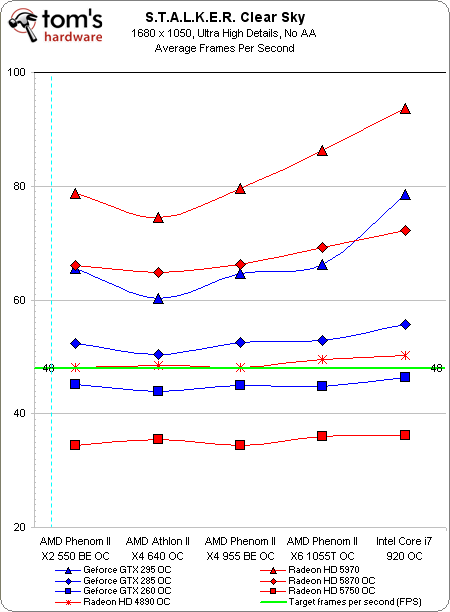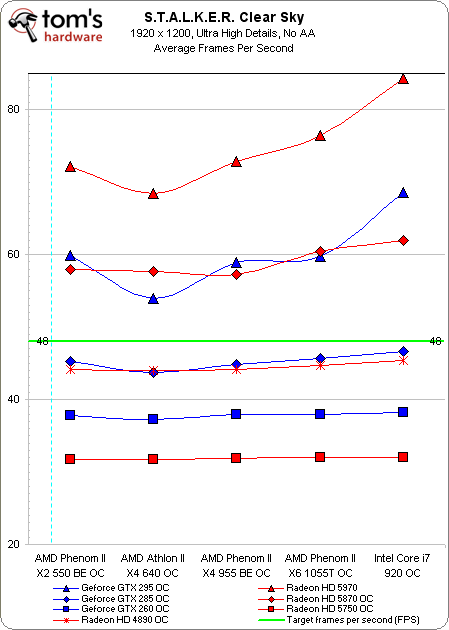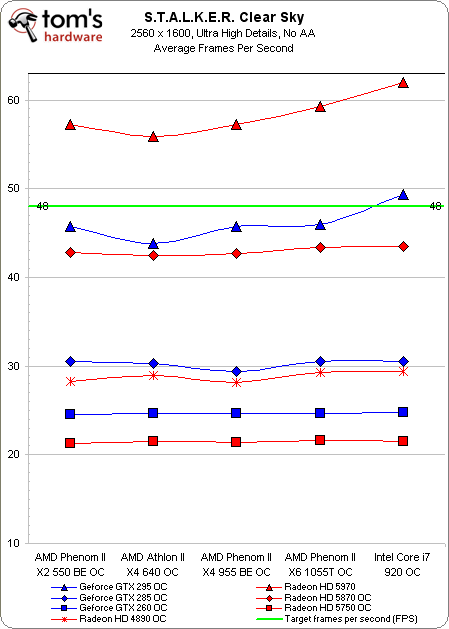Part 4: Building A Balanced Gaming PC
What does it mean to build a truly-balanced PC? How great would it be to piece together a machine bottlenecked by neither CPU or GPU? We set forth to measure the perfect balance in seven different games and four resolutions in this fourth of many parts.
Benchmark Results: S.T.A.L.K.E.R.: Clear Sky
S.T.A.L.K.E.R.: Clear Sky
S.T.A.L.K.E.R.: Clear Sky represents the second game so graphically intensive that we are unable to maximize the quality details and enable AA at the same time. The game is not known for being well-threaded, so any of our tested dual-core CPUs are capable of delivering playable performance. In essence, what’s going to determine playability in S.T.A.L.K.E.R. is having enough GPU muscle for the resolution at which you hope to game at.
We typically use an average of the four scores given by the stand-alone benchmark to measure S.T.A.L.K.E.R. performance. But for this story, we spent some time playing the game on various hardware, and then came close to utilizing a FRAPS benchmark run instead. Unlike Crysis, you do not really need to get far into S.T.A.L.K.E.R. before the game shows your hardware just what it’s going to be up against. All that it takes is exiting a building for the first time while the morning sun rays shine into camp.
For Parts 1 and 2 of this series, we still found the benchmark tool useful, but we needed to set the minimum target at 45 FPS on average. In every scenario benchmarked, if the overall average was 45 FPS, the “Sun Shafts” test averaged about 30 FPS. Overclocking these CPUs has increased averages through higher framerates in the less GPU-demanding tests, meaning an adjustment of our target to 48 FPS needed to be made to maintain the desired 30 FPS Sun Shafts performance. Playing the game at these settings still results in areas where the frame rates drop to the mid 20s, but overall still seemed to represent what we could consider playable performance.
The overclocked Radeon HD 5750 averages around 45 FPS, managing just 24.9 FPS in the Sun Shafts test, regardless of CPU pairing. The GeForce GTX 260 and Radeon HD 4890 are more up to the task. Results are already quite GPU-limited, with some scaling by CPU core speed and architecture.
Bumping up the resolution, the GeForce GTX 260 now falls to between 25-27 FPS in the most GPU-demanding test. More acceptable performance can be found by using the Radeon HD 4890 or higher, again paired with any of these overclocked processors.
At 1920x1200, the factory overclocked GeForce GTX 285 now falters to 27 FPS in the Sun Shafts test. Stepping up to the Radeon HD 5870 provides at least a 14 FPS boost in performance, more importantly adding about 10 frames per second to the most GPU-intensive test.
Get Tom's Hardware's best news and in-depth reviews, straight to your inbox.
S.T.A.L.K.E.R. at 2560x1600 was one of the two game tests where none of our stock platforms were able to deliver playable performance in Parts 1 and 2. Of course, keep in mind this was prior to adding the Radeon HD 5970 to the mix.
Paired with Core i7-920, the overclocked GeForce GTX 295 delivers the 30 FPS we seek, while averaging almost 50 FPS overall. Matching it up to the AMD platform drops it just below our target, losing 1-2 FPS in the Sun Shafts test, and 3-6 FPS on average. While the GTX 295 is borderline-playable on this platform, the Radeon HD 5970 still delivers an additional 10 FPS. Any one of the CPUs is adequate, but it’s hard to argue against more processing muscle when you're dumping nearly $700 into graphics and over $1000 into a 2560x1600 display.
Current page: Benchmark Results: S.T.A.L.K.E.R.: Clear Sky
Prev Page Benchmark Results: Far Cry 2 Next Page Benchmark Results: Grand Theft Auto IV-
wildeast "such as NVidia’s GeForce GTX 400-series and revamp the benchmark suite with some new DirectX 11 titles."Reply
i'll be waiting for that, and maybe some i5 cpu to see what fit sli best -
jsowoc "We set forth to measure the perfect balance in seven different games and four resolutions in this third of many parts." (?)Reply
I think you copied this paragraph from part 3 and forgot to change it to 4... ;-) -
theshonen8899 With the amount of love you guys have for the Athlon x3 I was really hoping to see it on here :\Reply
I guess I can kind of predict where it'd fall though. -
L0tus Brilliant piece.Reply
I wish I had read this before building my system as I can see that I clearly spent too much on my CPU instead of GPU (i5-750 + HD5770) . Would have done much better with (X2 550 BE + HD5850) !
...ain't hind sight a b***h!
Also interesting to see how GPUs really start to distinguish themselves at higher resolutions. Again, brilliant work. -
TheStealthyOne I built a computer for my brother using a Phenom ii 550 paired with a 5770, and it screams! Fantastic gaming chip! It just goes to show you can achieve fantastic performance by planning and balance.Reply -
garlik_bread Personally, i'd be interested to see results from a card with less han 1GB RAM on the GPU.Reply
On the lower end of the spectrum, with the lower resolutions, is the 1GB really necessary?
Basically, i have a 512MB Asus 5770 and want to validate my purchase :D -
plasmastorm Still running a Maximus formula 775 board with a Q6600, 8gb ram and a Radeon 5850 but this is certainly handy for future reference.Reply
Probably skipping the i5/i7 generation as I can still play anything at max settings on my 22" monitor while running a 2nd for a film tho :) -
descendency plasmastormStill running a Maximus formula 775 board with a Q6600, 8gb ram and a Radeon 5850 but this is certainly handy for future reference.Probably skipping the i5/i7 generation as I can still play anything at max settings on my 22" monitor while running a 2nd for a film thoReply
i5/i7 isn't a generation. it's like 5 or so.
It's the same thing as C2D and C2Q



